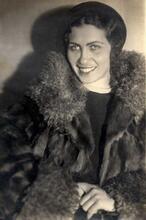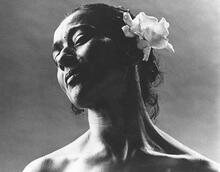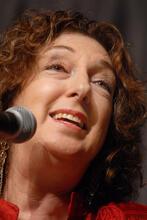Sara Levi-Tanai
Sara Levi-Tanai was the founder of the Inbal Dance Theater. With an original style and multiple talents, Levi-Tanai established a unique dance theater and created a new language of movement. She first created music and pursued a career in acting. Then, in 1949, “Operation Magic Carpet”--the huge mass immigration of Yemenite Jews to Israel--greatly inspired her. Levi-Tanai felt that as an artist she must seek out her own Yemenite roots. She recruited young people from the Yemenite community and established the dance company that later became the Inbal Dance Theater. Outstanding choreographers everywhere hailed her as one of the most innovative choreographers of her time. She won many honors and awards, including being made an honored citizen of Tel Aviv in 1988.
Sara Levi-Tanai was the founder, choreographer, and artistic director of the Inbal Dance Theater. With an original style and multiple talents (music, art, theater, dance), she established a unique dance theater that combines the East and West, the early history of the Nation of Israel with the present, nascent Israel—thus creating a new language of movement in the world of dance that is called “the Inbal language.”
Early Life and World War I
Sara Levi’s parents came to Palestine at the end of the nineteenth century as part of a group of Yemenite Jews who traveled on foot via Ethiopia. They settled in Jerusalem, where Sara, who never knew the precise date of her birth, was born in 1910 or 1911. At some point, the family moved to Neveh Zedek, on the border between Tel Aviv and Jaffa. In 1917, during World War I, when the Ottoman authorities expelled Jews from their homes in Jaffa, they fled to a refugee camp in Kefar Sava established by the Jewish Jewish community in Palestine prior to the establishment of the State of Israel. "Old Yishuv" refers to the Jewish community prior to 1882; "New Yishuv" to that following 1882.Yishuv. Amid the terrible conditions prevailing at the time, which included famine and a severe outbreak of typhus, all the members of her family perished save Sara and her father, who moved to Safed. Their poverty was so severe that Sara was placed in a home for Jewish war orphans.
After the war, Sara and other orphans were moved to the children’s home in Me’ir Shefeyah, which was headed by Moshe Calwary (1876–1944) and his wife, Hadassah. This proved to be formative in her life since it exposed her to western culture, literature, poetry, and art, as well as to Hebrew literature. Lacking other suitable space, Calwary would hang reproductions of Renaissance art on trees for the children to see and to arouse their interest. The intellectual stimuli and the broadening of horizons, together with the human sensitivity displayed by the entire staff, provided spiritual nourishment for Levi’s hungry soul and sustained her in the years that ensued. She revered her teachers. It is no wonder that Sara continued to regard Shefeyah as her home and that during, and even after, her years at a teachers’ seminary she spent her vacations there, working with the pupils on theatrical productions.
Teaching and Music Work
On completing her schooling in 1924/25, Levi went to the Levinsky Teachers’ Seminary to train as a nursery-school teacher. Her remarkable talent earned her a scholarship from the American Jewish Joint Distribution Committee, which also supported the Shefeyah home. Throughout her five years of study, her fees and living expenses were covered by Sophie Berger-Moll, a member of the JDC, whose assistance enabled Levi to study and to live modestly.
Levi’s first, part-time position was at a nursery school in the Shapira Quarter, a poor neighborhood in south Tel Aviv, where she proved so successful that she was promoted to a full-time post at the end of her first year. Lacking adequate teaching materials, she composed poems and set her own and others’ poetry to music and created games. The material she created was presented at the Organization of Nursery School Teachers as a collection of words and music, with instructions on the pedagogical and didactic methods for their use. This collection has served generations of teachers.
A number of collections of Levi-Tanai’s music have been published: some are of her own lyrics and music; some of her music with lyrics by others; some with music by other composers for her lyrics. In 1957 her work in this area won her the Tel Aviv Municipality’s Joel Engel (1868–1927) Prize, named after one of the country’s pioneer composers, with whom she herself studied. Her works have been taught as a unique oeuvre at the Academy for Music Teachers in Tel Aviv, directed by the composer Emmanuel Amiran Pougatchov (1909–1993), where she herself taught the children’s songs and games she had created. Since she could neither write nor read music, her compositions have been transcribed by others.
Theater Career and Jewish Artistic Expression
From early on, Levi dreamed of being an actress. As a child, she would gather her companions together and direct them in performances based on the tales of the Brothers Grimm. As a teacher, she performed in the theater established by the Organization of Nursery School Teachers. Hoping to make a career of acting, she joined the acting studio of Zevi Friedland (1898–1967), a director at Habimah, but she had no chance of being engaged by either of the two main theaters of the time, Habimah and Ohel because her pronounced Yemenite accent was unacceptable to the Ashkenazi members who governed the theater, most of whom were from Russia and had thick Russian accents which were acceptable to the theater-going Ashkenazi audiences.
Among the students at Friedland’s studio was Israel Tanai (1910–1962), who had arrived alone in the country from Europe in 1933 and whose family perished in the Holocaust. He and Levi married in 1935. In 1940, when Israel joined the Jewish Brigade, Sara and her newborn baby daughter Michal moved to A voluntary collective community, mainly agricultural, in which there is no private wealth and which is responsible for all the needs of its members and their families.kibbutz Ramat ha-Kovesh, where she worked in the nursery school until the end of the war and where her son Ya’akov was born in 1942. Here she began her major artistic work, becoming part of a movement of artists searching for a more authentic mode of expression in Jewish forms. She staged the holiday ceremonies in which the entire kibbutz community participated. She created her first major performance—Shir ha-Shirim (Song of Songs)—for which she composed the music. Some of the songs from this performance became famous Israeli songs, such as “El Ginat Egoz” (To the Nut Grove) and “Kol Dodi” (The Voice of My Beloved). Both adults and children of the kibbutz performed in this theatrical production.
The enormous success of Song of Songs at Ramat ha-Kovesh led to an invitation from Kibbutz Mishmar ha-Sharon to create a performance celebrating their absorption of a group of Youth Aliya members. Based on the Book of Ruth, this took place on Lit. "weeks." A one-day festival (two days outside Israel) held on the 6th day of the Hebrew month of Sivan (50 days, or 7 complete weeks, from the first day of Passover) to commemorate the Giving of the Torah on Mount Sinai; Pentecost; "Festival of the First Fruits"; "Festival of the Giving of the Torah"; Azeret (solemn assembly).Shavuot 1947. In 1950, to mark the twenty-fifth anniversary of Mishmar ha-Sharon, she created Bereshit (Genesis) in collaboration with the composer Emmanuel Amiran Pougatchov. These productions established her as an artist with an original style. She was one of the principal contributors to the development of the folkdance movement that was established in the late 1940s. The uniqueness of Levi-Tanai lay in her interpretations of the Biblical texts and the wide scope of these creations, which included movement, text, music and a large variety of performers. This style was later the basis for her Biblical creations for the Inbal Dance Theater.
Inbal Dance Theater
In 1945, when her husband was demobilized from the Jewish Brigade, she and the children left the kibbutz and returned to Tel Aviv. A few years later, in 1949, “Operation Magic Carpet,” the huge mass immigration of Yemenite Jews to Israel, greatly inspired the future of her career. Although she had grown up amid western culture, she felt that as an artist she must seek out her own roots. Since it was clear to her that artistic creation requires organic growth she turned to her own ethnic group.
Levi-Tanai recruited young people from the Yemenite community—from among both the new immigrants and those whose families had arrived earlier—and began working with them. At first, large numbers of youngsters came to train with her two nights a week at the music teachers’ academy at which she taught. A small group of seven youngsters continued to return—four girls and three boys—and with them she established the dance company that later became the Inbal Dance Theater.
With no intention of establishing a folklore group, Levi-Tanai instead used elements of Yemenite Jewish folklore as the building blocks for creating a new language of movement. Her uniqueness expressed itself not just through this new language of movement, but also by its style—dance-theater, which was very new. Through her work at Inbal, where she created more than seventy ballets, Sara Levi-Tanai made a major contribution to Israeli culture. Artists in various media—music, scenery, and costume—who were neither Yemenite nor Lit. "Eastern." Jew from Arab or Muslim country.Mizrahi, but of Ashkenazi origin, worked for the company and were profoundly influenced by her concepts and compositions.
Awards and Legacy
Outstanding choreographers everywhere hailed her as one of the most innovative choreographers of her time. On their tours abroad, she and the company were widely acclaimed. In 1964, her Book of Ruth won her an award from the Théâtre des Mondes in Paris. In 1973 she was awarded the prestigious Israel Prize in music and dance and in 1984 she won the Moshe Halevi Theater Prize, awarded by the Tel Aviv Municipality. In 1986 she was the first recipient of the Israel Labor Federation (Histadrut) Prize for music and dance. In 1988 she was made an honored citizen of Tel Aviv.
During the last years of her life, Levi-Tanai lived in Kefar Sava near Tel Aviv, but was transferred to a hospital in Ramat Gan, where she died on October 3, 2005.
Toledano, Gila. Story of a Company: Sara Levi-Tanai and the Inbal Dance Theater (Hebrew). Tel Aviv: 2005













